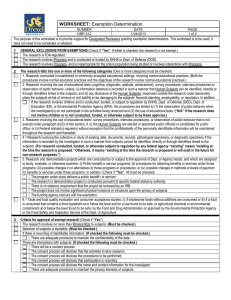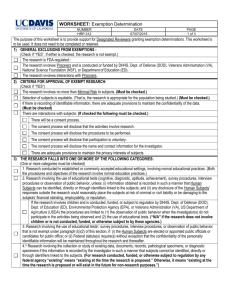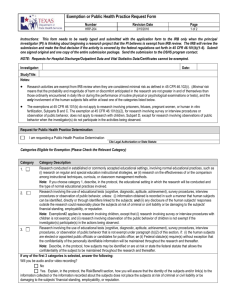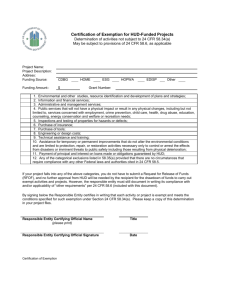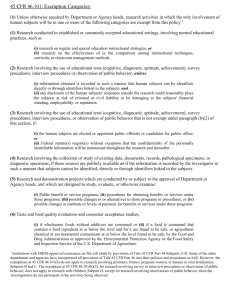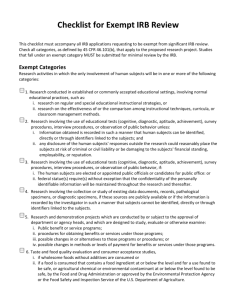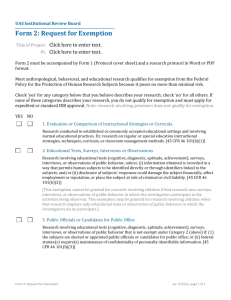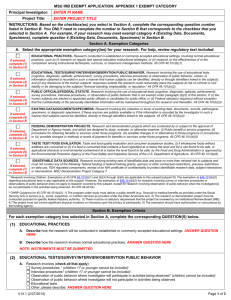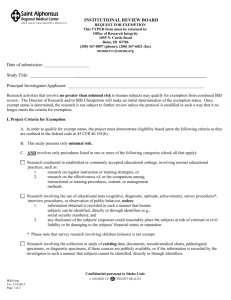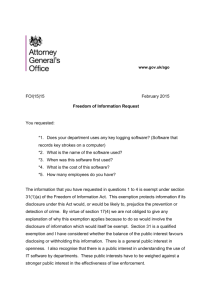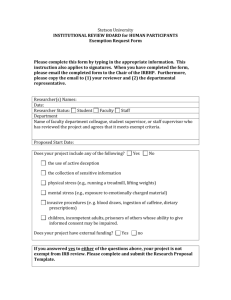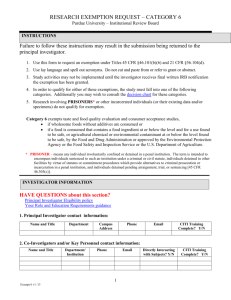CHECKLIST: Exemption Determination
advertisement
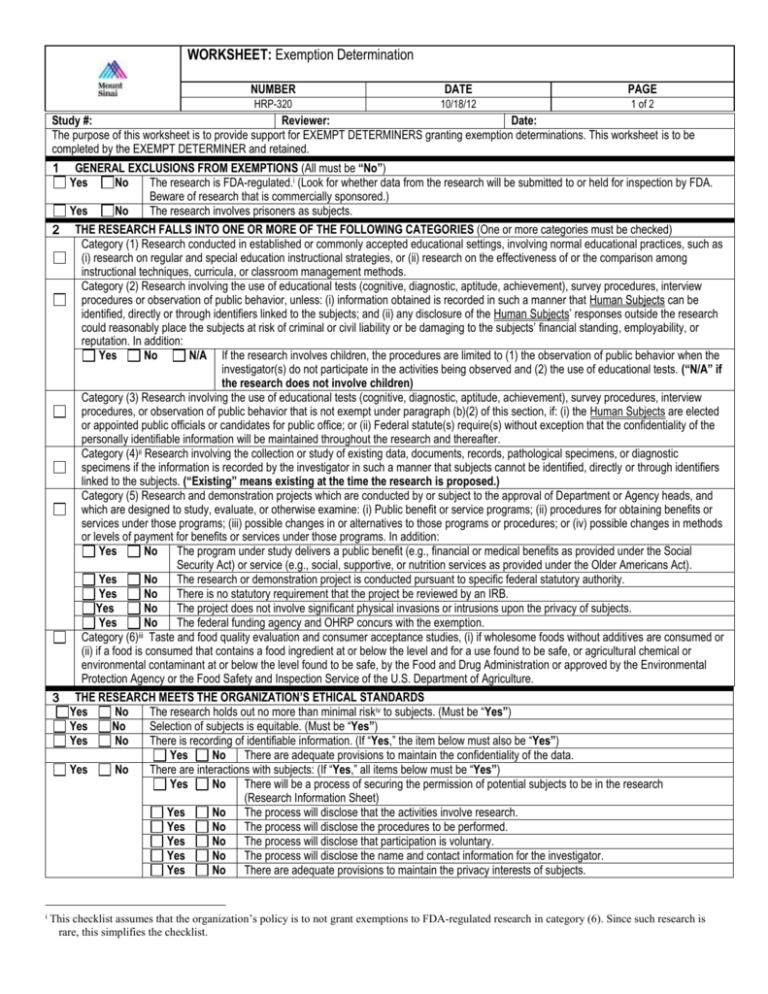
WORKSHEET: Exemption Determination NUMBER DATE PAGE HRP-320 10/18/12 1 of 2 Study #: Reviewer: Date: The purpose of this worksheet is to provide support for EXEMPT DETERMINERS granting exemption determinations. This worksheet is to be completed by the EXEMPT DETERMINER and retained. 1 2 3 i GENERAL EXCLUSIONS FROM EXEMPTIONS (All must be “No”) Yes No The research is FDA-regulated.i (Look for whether data from the research will be submitted to or held for inspection by FDA. Beware of research that is commercially sponsored.) Yes No The research involves prisoners as subjects. THE RESEARCH FALLS INTO ONE OR MORE OF THE FOLLOWING CATEGORIES (One or more categories must be checked) Category (1) Research conducted in established or commonly accepted educational settings, involving normal educational practices, such as (i) research on regular and special education instructional strategies, or (ii) research on the effectiveness of or the comparison among instructional techniques, curricula, or classroom management methods. Category (2) Research involving the use of educational tests (cognitive, diagnostic, aptitude, achievement), survey procedures, interview procedures or observation of public behavior, unless: (i) information obtained is recorded in such a manner that Human Subjects can be identified, directly or through identifiers linked to the subjects; and (ii) any disclosure of the Human Subjects’ responses outside the research could reasonably place the subjects at risk of criminal or civil liability or be damaging to the subjects’ financial standing, employability, or reputation. In addition: Yes No N/A If the research involves children, the procedures are limited to (1) the observation of public behavior when the investigator(s) do not participate in the activities being observed and (2) the use of educational tests. (“N/A” if the research does not involve children) Category (3) Research involving the use of educational tests (cognitive, diagnostic, aptitude, achievement), survey procedures, interview procedures, or observation of public behavior that is not exempt under paragraph (b)(2) of this section, if: (i) the Human Subjects are elected or appointed public officials or candidates for public office; or (ii) Federal statute(s) require(s) without exception that the confidentiality of the personally identifiable information will be maintained throughout the research and thereafter. Category (4)ii Research involving the collection or study of existing data, documents, records, pathological specimens, or diagnostic specimens if the information is recorded by the investigator in such a manner that subjects cannot be identified, directly or through identifiers linked to the subjects. (“Existing” means existing at the time the research is proposed.) Category (5) Research and demonstration projects which are conducted by or subject to the approval of Department or Agency heads, and which are designed to study, evaluate, or otherwise examine: (i) Public benefit or service programs; (ii) procedures for obtaining benefits or services under those programs; (iii) possible changes in or alternatives to those programs or procedures; or (iv) possible changes in methods or levels of payment for benefits or services under those programs. In addition: Yes No The program under study delivers a public benefit (e.g., financial or medical benefits as provided under the Social Security Act) or service (e.g., social, supportive, or nutrition services as provided under the Older Americans Act). Yes No The research or demonstration project is conducted pursuant to specific federal statutory authority. Yes No There is no statutory requirement that the project be reviewed by an IRB. Yes No The project does not involve significant physical invasions or intrusions upon the privacy of subjects. Yes No The federal funding agency and OHRP concurs with the exemption. Category (6)iii Taste and food quality evaluation and consumer acceptance studies, (i) if wholesome foods without additives are consumed or (ii) if a food is consumed that contains a food ingredient at or below the level and for a use found to be safe, or agricultural chemical or environmental contaminant at or below the level found to be safe, by the Food and Drug Administration or approved by the Environmental Protection Agency or the Food Safety and Inspection Service of the U.S. Department of Agriculture. THE RESEARCH MEETS THE ORGANIZATION’S ETHICAL STANDARDS Yes No The research holds out no more than minimal riskiv to subjects. (Must be “Yes”) Yes No Selection of subjects is equitable. (Must be “Yes”) Yes No There is recording of identifiable information. (If “Yes,” the item below must also be “Yes”) Yes No There are adequate provisions to maintain the confidentiality of the data. Yes No There are interactions with subjects: (If “Yes,” all items below must be “Yes”) Yes No There will be a process of securing the permission of potential subjects to be in the research (Research Information Sheet) Yes No The process will disclose that the activities involve research. Yes No The process will disclose the procedures to be performed. Yes No The process will disclose that participation is voluntary. Yes No The process will disclose the name and contact information for the investigator. Yes No There are adequate provisions to maintain the privacy interests of subjects. This checklist assumes that the organization’s policy is to not grant exemptions to FDA-regulated research in category (6). Since such research is rare, this simplifies the checklist. WORKSHEET: Exemption Determination NUMBER DATE PAGE HRP-320 10/18/12 2 of 2 “If these sources are publicly available” was removed because public data cannot be private, and if there is no collection of private identifiable data, there can be no Human Subjects. iii Note that for FDA-regulated research exemption (6) is an exemption from IRB review in 21 CFR §56, but unlike DHHS regulations is not an exemption from FDA requirements for consent in 21 CFR §50. If an organization’s policy is to grant exemptions to FDA-regulated research in category (6), then additional criteria for such exemptions would be that consent will be obtained in accordance with 21 CFR §50.20 and §50.25, and the consent will be either be documented in writing in accordance with 21 CFR§50.27 or waived in accordance with 21 CFR §56.109(c)(1). iv Minimal risk means that the probability and magnitude of harm or discomfort anticipated in the research are not greater in and of themselves than those ordinarily encountered in daily life of normal persons or during the performance of routine physical or psychological examinations or tests in normal persons. ii
